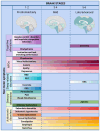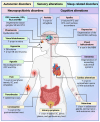Redefining Non-Motor Symptoms in Parkinson's Disease
- PMID: 40423044
- PMCID: PMC12112995
- DOI: 10.3390/jpm15050172
Redefining Non-Motor Symptoms in Parkinson's Disease
Abstract
Parkinson's disease involves widespread neurodegeneration that extends far beyond the basal ganglia, giving rise to a diverse range of non-motor symptoms that frequently emerge before motor onset. These include autonomic dysfunction, cognitive decline, neuropsychiatric disturbances, sleep-related disorders, and sensory deficits. Here, we synthesize current evidence on the anatomical, neurochemical, and network-level mechanisms that drive these symptoms, and we examine how they shape disease progression and clinical heterogeneity. We highlight the limitations of dopamine-centric models and advocate for a framework that treats non-motor symptoms as the disorder's primary, mechanistically distinct features. We also discuss how emerging technologies-such as multi-omic profiling, artificial intelligence, and network neuroscience-enable earlier identification, stratification of non-motor phenotypes, and the development of precision-based therapeutic strategies. Recognizing non-motor symptoms as central to Parkinson's disease redefines how the disorder should be diagnosed, studied, and treated.
Keywords: Parkinson’s disease; REM sleep behavior disorder; autonomic dysfunction; biomarkers; cognitive impairment; neuropsychiatric disorders; non-motor symptoms; pain; sensory dysfunction; sleep-related disorders.
Conflict of interest statement
The authors declare no conflicts of interest.
Figures


Similar articles
-
Clinical criteria for subtyping Parkinson's disease: biomarkers and longitudinal progression.Brain. 2017 Jul 1;140(7):1959-1976. doi: 10.1093/brain/awx118. Brain. 2017. PMID: 28549077
-
Prediagnostic presentations of Parkinson's disease in primary care: a case-control study.Lancet Neurol. 2015 Jan;14(1):57-64. doi: 10.1016/S1474-4422(14)70287-X. Epub 2014 Nov 27. Lancet Neurol. 2015. PMID: 25435387
-
Early phenotypic differences between Parkinson's disease patients with and without freezing of gait.Parkinsonism Relat Disord. 2014 Jun;20(6):604-7. doi: 10.1016/j.parkreldis.2014.02.028. Epub 2014 Mar 12. Parkinsonism Relat Disord. 2014. PMID: 24679901
-
Spectrum of Non-Motor Symptoms in Parkinson's Disease.Cureus. 2021 Feb 11;13(2):e13275. doi: 10.7759/cureus.13275. Cureus. 2021. PMID: 33728210 Free PMC article. Review.
-
Neurological Insights into Sleep Disorders in Parkinson's Disease.Brain Sci. 2023 Aug 14;13(8):1202. doi: 10.3390/brainsci13081202. Brain Sci. 2023. PMID: 37626558 Free PMC article. Review.
Cited by
-
Assessment of Health-Related Quality of Life in Parkinson's Disease: A Systematic Review.Cureus. 2025 Jul 16;17(7):e88061. doi: 10.7759/cureus.88061. eCollection 2025 Jul. Cureus. 2025. PMID: 40821187 Free PMC article. Review.
References
-
- Martinez-Martin P., Manuel Rojo-Abuin J., Rizos A., Rodriguez-Blazquez C., Trenkwalder C., Perkins L., Sauerbier A., Odin P., Antonini A., Chaudhuri K.R. Distribution and impact on quality of life of the pain modalities assessed by the King’s Parkinson’s disease pain scale. NPJ Park.’s Dis. 2017;3:8. doi: 10.1038/s41531-017-0009-1. - DOI - PMC - PubMed
Publication types
LinkOut - more resources
Full Text Sources

